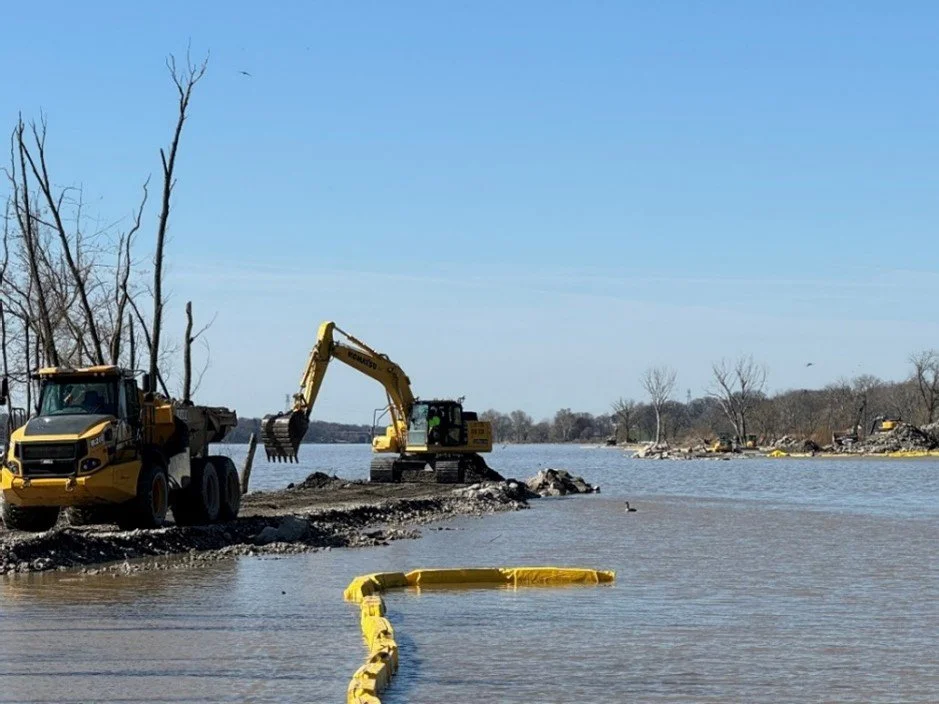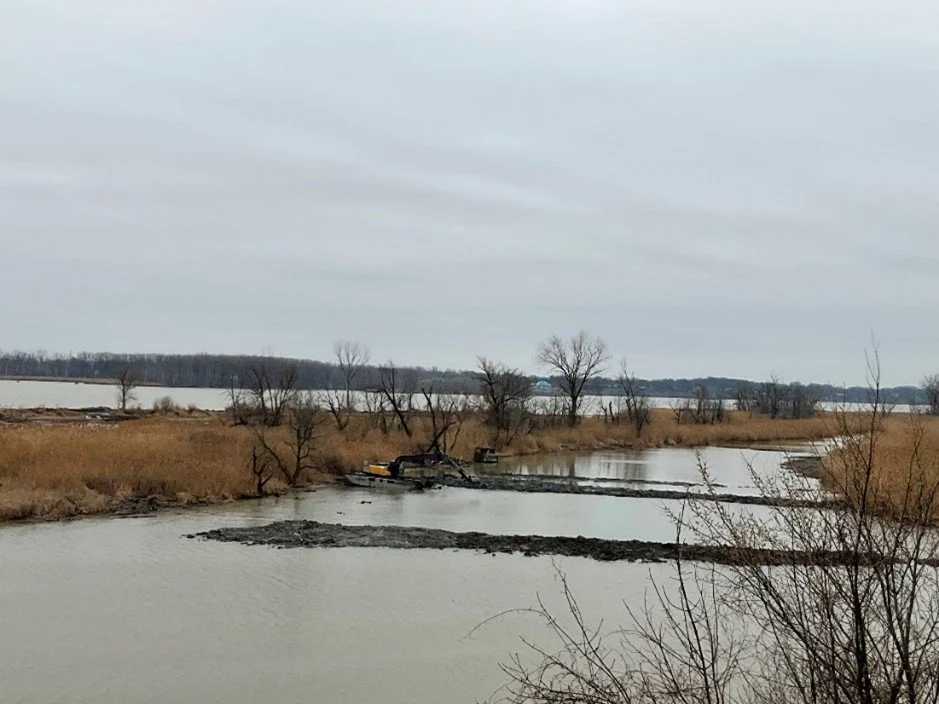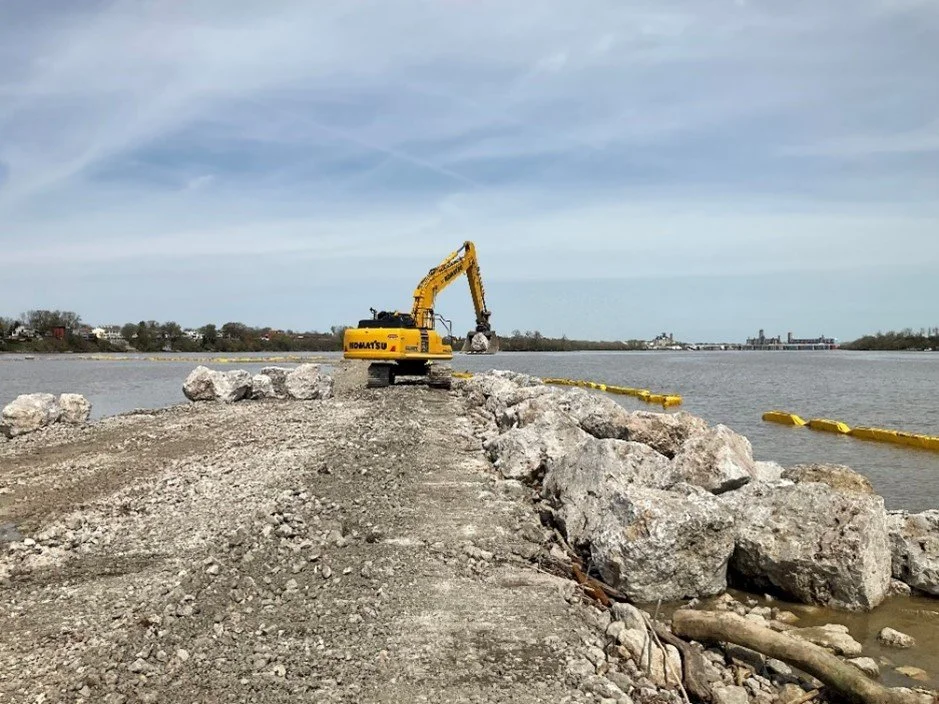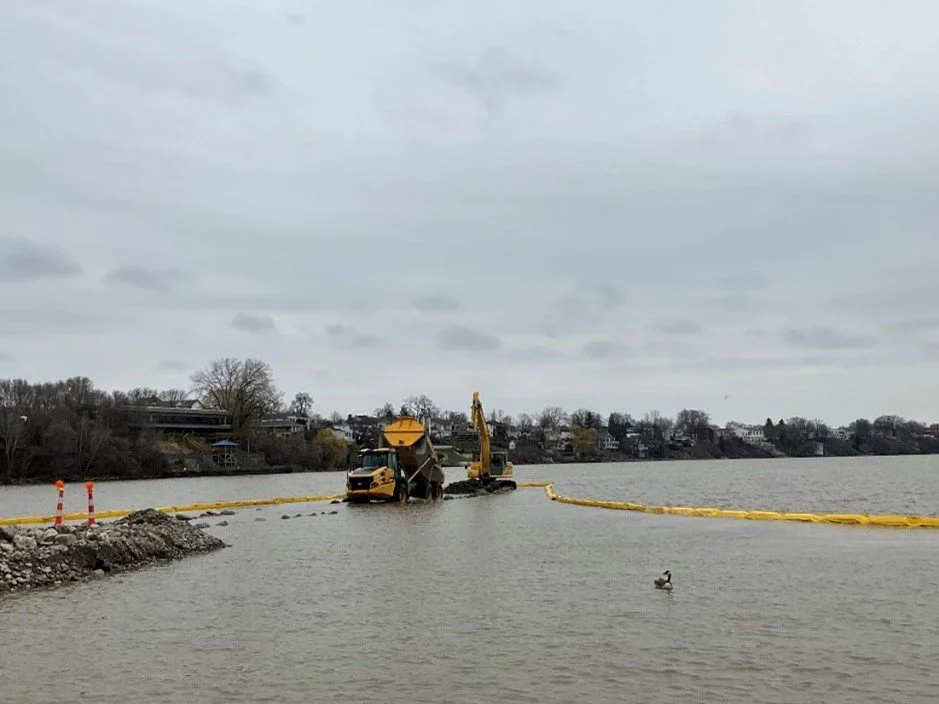H2Ohio and GLRI Projects
Clark and Delaware/Horseshoe Islands Restoration Projects
Scroll to the bottom of the page to see monthly updates.
Construction of the Clark and Delaware/Horseshoe Islands Restoration Project is underway! Mark Haynes Construction is the Toledo-Lucas County Port Authority’s construction contractor leading efforts to restore and protect these City of Toledo-owned islands in the Maumee River near Walbridge Park.
Staging areas were established for each of the two island areas: a gravel lot downstream from the Maumee River Yacht Club for work at the Delaware/Horseshoe Islands and the lower level of the public boat launch parking lot for work at Clark Island. Construction of the temporary construction causeways began the second week of January 2024. The two causeways will connect the shoreline to the island areas to allow construction equipment to access the island improvement areas. They will have culverts to allow for water flow and fish passage. The public is not allowed to use the causeways for any purpose.
All construction is currently scheduled for completion in fall 2025. While the City’s public boat ramp will remain open throughout the project, limited parking will be available at the lower level. All vehicles (with or without trailers) are requested to park in the upper lot. Based on additional conversations with boating community representatives in fall 2023, the two causeways are planned to remain in-place throughout the construction duration. Boaters using the public launch and those docked at the Yacht Club that typically travel through the deeper channel between the two former island footprints will need to follow alternate paths marked with temporary buoys to get to the main river channel.
The Toledo-Lucas County Port Authority is leading this effort in partnership with the City of Toledo, with significant input from the Ohio Department of Natural Resources (ODNR) and Ohio Environmental Protection Agency (Ohio EPA), and with support from the Maumee Area of Concern (AOC) Advisory Committee (MAAC).
The Port Authority received funding from the H2Ohio program and Great Lakes Restoration Initiative (GLRI) to complete this construction and the previous engineering, design, and permit preparation activities. While both projects offer nutrient reduction and habitat improvements, plans for H2Ohio-funded activities focus primarily on nutrient reduction through sediment settlement and plant uptake and GLRI-funded planning activities focus primarily on improving habitat for fish and benthos (small organisms that live on the river bottom).
The engineering, design, and construction planning activities were finalized in June 2023 and reflect significant stakeholder input gathered through discussions with more than 100 individuals during small meetings and public open house sessions. Plans were completed under the direction of the collaborating agencies and were led by engineers and scientists at Verdantas (formerly Hull & Associates, LLC), with input from several specialists, including modeling experts at LimnoTech and biologists at the University of Toledo.
Details of Project Plans
The H2Ohio-funded project footprint includes the downstream portion of Delaware/Horseshoe Island and the entirety of Clark Island. This is an approximately 13.6-acre area with around 6.9 acres of wetlands.
H2Ohio project features include:
Wetland Area
Open Backwater Area
Island Revetment
Inner Channel Reef
Breakwater/Backwater Islands
The contractor will restore a portion of the original island footprint and install a rock revetment to protect the improved area from river flows, boat wakes, and ice scour. They will establish an interior, protected open water area ideal for sediment deposition. Small islands and stone and wood structures will be installed in that area to provide important habitat in this system while slowing down water flows and promoting sediment settlement.
The GLRI-funded project, recommended through the MAAC, includes Delaware/Horseshoe Island. This project involves an approximately 50-acre improvement area with approximately 12 acres of regraded and enhanced wetlands and 29 acres where phragmites will be managed.
GLRI-MAAC project features include:
Wetland Area
Rock Barrier Reef/Vegetated Stone Sill
Cove Improvements
Open Water Improvements/Enhancements
Invasive Species Management
More specifically, the contractor will restore a portion of the original island footprint and will improve habitat for fish and benthos, as well as enhance upland wildlife habitat. An installed rock barrier reef/vegetated stone sill will create calm, open water habitat and provide protection from river flows, boat wakes, and ice scour. Coves will be contoured with varying depths, providing areas with suitable habitat at different water levels. The installed wood/rock structures and added variety of gravel and other bottom substrate will enhance fish and macroinvertebrate habitat. This project will also result in nutrient reduction through plant uptake and sediment settlement.
Planned Project Benefits
Reduced sedimentation and nutrient loading in the Maumee River and Lake Erie, resulting in water quality improvements
Improved habitat for fish, benthos, and other species
Protected and enhanced island and shoreline habitat that will:
Reduce further erosion of the islands
Create resilience in ecological systems to withstand higher and more variable river flows
Protect existing park and recreational boating infrastructure
Engineering Considerations and Details
Engineers and scientists on the project team spent considerable time analyzing current and potential conditions and designing durable and functional restoration plans. Some of these considerations and conclusions include:
High Velocity Currents and Ice: It is well known that ice flows can be thick and destructive in the Maumee River. The design team included the revetment and reef structures in the plans to protect the islands from potential ice impacts. The modeling work and resulting design also consider high velocity currents during heavy precipitation and melting events. Project engineers specified the size of rock to withstand harsh conditions over the long-term based on standardized design methodologies.
Sources of Material: The contractor is using rock from quarries in the region. Some of the stone materials for the causeways are being reused from the recently decommissioned I-75 (DiSalle) Bridge construction causeway. For the H2Ohio project, the fill material is anticipated to be primarily soil from off-site locations. Other sources may be considered for use by the contractor, and they will have to obtain appropriate approvals to use proposed materials. For the MAAC project, the project is designed to have a balance between material dredged from the existing coves and open water areas and the placement of that material to build up the existing island footprint. The contractor will also procure a variety of native vegetation that will be planted on the islands and may include grasses, shrubs, and trees. Woody debris will also be collected/procured from local sources.
Recreational Boating and Paddling Considerations
The temporary construction causeways will stay in place throughout the duration of construction. The project team understands that we must maintain boater access to the main river channel for the users of the City of Toledo’s Walbridge Park public boat ramp, Toledo Sailing Club, and the Maumee River Yacht Club. At the onset of boating season, the project team will work with the City of Toledo and the two boating clubs to share information on how to best navigate to the main river channel and the alternate paths will be marked by buoys. The project team will ensure that all constructed improvements consider safe boating navigation and the existing navigation lights will be realigned to reflect recent conditions (they have been out of alignment for years).
Post-construction, paddlers are anticipated to be allowed to enter into the protected open water areas of the islands but will be asked not to traverse on the rocks or upland areas of the islands. The depths in the open water areas will vary based on lake levels and storm events, but generally are anticipated to range from one-foot to four-feet deep.
Maintenance
Restoration designs considered and prioritized improvements that will minimize long-term maintenance needs. As the owner of the islands, the City of Toledo will be responsible for maintaining the islands. They will follow the recommendations detailed in the long-term maintenance plans prepared during the engineering and design effort.
Supporting Studies
Recent biological assessments and other studies that support the need for this work include the 2019-2020 Identification of Optimal Sites for Maumee AOC Restoration Actions in the Lower Maumee River prepared by the University of Toledo and Bowling Green State University; the 2020-2021 Lower Maumee River Restoration Design Concepts prepared by the University of Toledo, Bowling Green State University, and Hull/Verdantas; and the 2021-2022 U.S. Army Corps of Engineers’ feasibility study entitled, Summary of Concepts at Selected Sites – Lower Maumee River Habitat Restoration Projects. Descriptions and links to all previously completed studies and reports are in the Lower Maumee River Pre-Feasibility Studies and Lower Maumee River Project Development Feasibility Study project summaries in the Maumee AOC DMDS program.
Please click here to download the renderings.
Please click here to view the construction schedule.









Construction of temporary access route and backfilling of wetland area along inner channel reef at Clark Island; facing southwest.
MONTHLY UPDATES
APRIL 2024 - Mark Haynes Construction is currently working on constructing the perimeter rock berm/revetment structures at Clark and Delaware/Horseshoe Islands and backfilling wetland areas. They are also dredging the coves at Delaware/Horseshoe Islands to create varying depths, providing habitat at different water levels.
Excavator dredging the west cove of Delaware/Horseshoe Island; facing southeast.
Excavator placing rock for the island perimeter berm/revetment at Clark Island; facing northeast.
Placement of rock for the inner channel reef at Clark Island; facing northwest.




